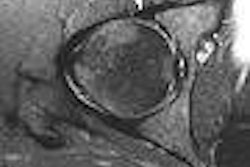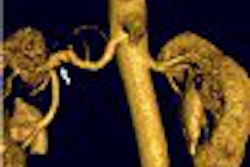Lower back pain is one of the more common adult patient presentations to primary care physicians in the U.S. The primary care physician has several options to offer patients for the management of their symptoms. Among these is referral to a specialist or the ordering of diagnostic imaging. And when it comes to the modality most frequently requested by primary care physicians for imaging lower back pain, MRI is rapidly becoming their modality of choice.
"We found in our facility, over a one-year period, approximately 50% of the MRIs for low back pain were ordered by primary care physicians," said Joel Fallano.
Fallano, a doctor of physical therapy (DPT) from the Center for Evidence-Based Imaging at Brigham and Women's Hospital in Boston, presented results at the 2005 RSNA conference in Chicago from a study conducted at his institution assessing the frequency of MRI for low back pain by primary care physicians.
Several guidelines have been established to assist physicians in their decision-making process for the use of MRI with patients with low back pain. The American College of Radiology (ACR), the Agency for Healthcare Research and Quality (AHRQ), and the American Academy of Orthopaedic Surgeons (AAOS) are among the groups that have published guidelines for the appropriate use of imaging for low back pain.
Fallano and his team sought to determine how often primary care physicians ordered MRIs for low back pain in the routine workup of uncomplicated cases, which were defined by the researchers as the absence of key clinical findings as published in the ACR Appropriateness Criteria.
"The ACR red flags (key clinical findings) for the use of MRI for low back pain are any recent or significant trauma or any milder trauma after the age of 50, unexplained weight loss, unexplained fever, immunosuppression, history of cancer, IV drug use, prolonged use of cortical steroids, osteoporosis, and age over 70," Fallano said.
The group identified all outpatients who had an MRI performed for lower back pain as requested by their primary care physicians using a computerized physician order entry (CPOE) application (Percipio, Medicalis, Kitchener, Ontario) during a 17-month period.
The researchers conducted an implicit and explicit electronic medical record review, using the clinical red flags as described by the ACR Appropriateness Criteria, of 50 randomly selected patient records from the 927 eligible candidates in their patient cohort. Of the 50 patients, 39 were female and 11 were male, with a mean age of 51, plus or minus 13 years, according to Fallano.
"We found that 23 of the patients had low back pain for greater than six weeks, two of them had pain for four to six weeks, four had pain for three to four weeks, and eight had low back pain for less than two weeks," he said. "The duration of the symptoms were not documented in the other 13 patient records."
More importantly, from the standpoint of clinical appropriateness, in 29 of the patient records no clinical red flags were documented. Of the 21 records that had clinical red flags documented, recent significant trauma was present in three patients (6%), known malignancy in five patients (10%), prolonged use of steroids or osteoporosis in nine patients (18%), and four patients were over the age of 70 (8%), according to Fallano.
He noted that the study was limited to what was available to the researchers from the CPOE records, and other elements of the patients' medical histories may not have been entered by the primary care physicians at the time of ordering. However, on the basis of the team's study, Fallano observed that approximately 58% of the MRIs requested by primary care physicians at his institution for the workup of low back pain had no documented clinical red flags in the medical record.
By Jonathan S. Batchelor
AuntMinnie.com staff writer
January 31, 2006
Related Reading
Coding for the back shouldn't be a pain, November 8, 2005
Cautions against CT overuse fall on deaf ears at West Virginia ER, September 27, 2005
Massachusetts insurers seek to cut imaging utilization, September 12, 2005
Study finds MRI is overused in sports medicine, February 24, 2005
ACR criteria cut imaging costs in Israel, January 11, 2005
Copyright © 2006 AuntMinnie.com



















